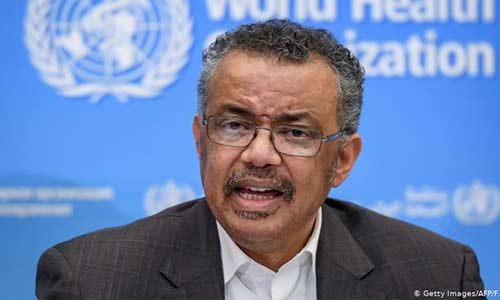Modern technology and international cooperation could limit the coronavirus pandemic to less than two years, World Health Organisation (WHO) chief Tedros Adhanom Ghebreyesus said on Friday.
“Hoping we can have additional tools like a vaccine, I think we can finish it in a shorter time than the 1918 flu,” he told a news conference in Geneva, referring to the Spanish flu pandemic that claimed tens of millions of lives until 1920.
While the novel coronavirus can spread more easily because the world is far more interconnected than it was 100 years ago, modern technology has given humanity the tools to fight COVID-19 more effectively than the Spanish flu, Tedros said.
“So we hope to finish this pandemic in less than two years,” he said.
However, Tedros warned that “even if we do have a vaccine, it won’t end the pandemic on its own.”
Countries must not simply bank on a future vaccine but must implement known effective health measures, while people must adjust their lives to curb infections, the UN health chief stressed.
COVID-19 is believed to have originated in China late last year.
Since then, more than 22 million cases and some 780,000 associated deaths have been reported around the world, according to the WHO.
Addressing more immediate concerns among parents in many countries where new school terms are starting, senior WHO scientist Maria Van Kerkhove said that the pandemic must be fought in the communities where children and teachers live.
If the novel coronavirus is spreading rapidly through communities, it can also enter schools, she said at the press briefing.
“It is really critical that we bring outbreaks under control and transmission under control in areas where schools operate,” Van Kerkhove said, in response to a question about whether WHO recommends reopening schools as cases increase in several European countries.
Schools do not only educate, but also play a vital role in feeding children and providing social interaction, said Van Kerkhove, WHO’s chief COVID-19 scientist.
As mask requirements for young people differ by country, the WHO plans to issue guidance on face coverings for children in different age groups in the coming days.
WHO emergency operations chief Mike Ryan warned, however, that masks are just one of many tools to control the virus’ spread, and that they are not a substitute for social distancing or for a lower number of students in classes.
Van Kerkhove acknowledged that scientific knowledge is still limited about children and the transmission of the virus.
“Studies are preliminary and few,” she said.
What is known is that children of all ages can become infected, but they that they usually suffer only mild symptoms, she said. (dpa/NAN)
